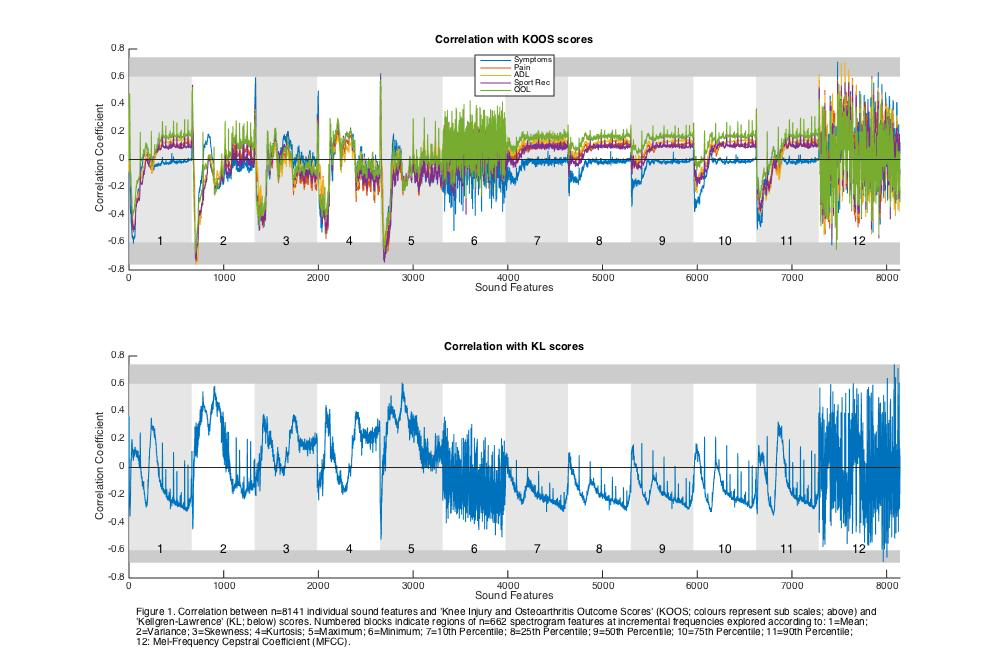Session Information
Date: Tuesday, November 10, 2015
Title: Osteoarthritis - Clinical Aspects Poster II: Biomarkers, Biomechanics and Health Services Research
Session Type: ACR Poster Session C
Session Time: 9:00AM-11:00AM
Background/Purpose:
Knee sounds (KS) may provide a low-cost, risk-free means of identifying presence and severity of knee osteoarthritis (KOA). Unlike static imaging, KS during dynamic activity may correlate with symptoms and function. This study aimed to explore the association between KS, KOA severity, symptoms and function.
Methods:
Adults with clinical KOA (1986 ACR) were recruited from a UK orthopedic clinic by the attending surgeon (JC). Adults (at Imperial College London) reporting no previous knee pain >2 weeks were recruited. Knees were classified as: 1) OA, 2) healthy, 3) OA healthy (contralateral KOA). Exclusion criteria were: aged <18 years, previous surgery, unable to provide consent.
Severity of OAwas assessed (single rater) using the Kellgren-Lawrence (KL) radiographic scoring method. Knee symptoms and function were assessed via self-reported Knee Injury and Osteoarthritis Outcome Scores (KOOS). KS were acquired (rate 44-48kHz) during treadmill walking (4km/h) using a contact microphone (Basik Pro, Schertler, 20Hz to 20kHz) attached to the patella, supported by a digital preamplifier (RME Babyface; PreSonus DigiMax LT).
KS features were extracted from recordings using spectro-temporal and cepstral analysis, and correlations (r) with KL and KOOS explored. Features correlating over |r|>0.6 were used to train binary regression decision trees to identify KS feature-combinations predictive of KOOS. Pearson’s and Bland and Altman’s 95% limits of agreement (LOA) were used to assess association between predicted and true values.
Results:
Twenty-eight participants were recruited; 14 knees were excluded due to previous surgery, 42 knees were included (Table 1). OA healthy knees were excluded from KOOS. Twenty knee x-rays were available dating 10±7 (all ≤ 27) weeks pre-assessment.
Of 8,141 extracted KS features, 267 exceeded |r|>0.6 with KL and KOOS (Figure 1). Predicted KOOS were strongly correlated with true KOOS, except quality of life (QOL) (Figure 2); mean (95% LOA) = pain -0.8 (47.2 to -48.8); symptoms 0.2 (34.6 to -34.1), activities of daily living 0.7 (40.2 to -38.8); QOL 2.1 (67.1 to -63.0).
Conclusion:
These preliminary findings indicate that KS are predictive of OA symptoms and function, and possibly severity. Whilst encouraging, further investigation is required among a larger cohort.
To cite this abstract in AMA style:
Manning V, Yiallourides C, Brevadt M, Moore A, Auvinet E, Naylor P, Cobb J. Knee Sounds May Predict Osteoarthritis Severity, Symptoms and Function: Pilot Investigation Toward a Novel Dynamic Imaging System [abstract]. Arthritis Rheumatol. 2015; 67 (suppl 10). https://acrabstracts.org/abstract/knee-sounds-may-predict-osteoarthritis-severity-symptoms-and-function-pilot-investigation-toward-a-novel-dynamic-imaging-system/. Accessed .« Back to 2015 ACR/ARHP Annual Meeting
ACR Meeting Abstracts - https://acrabstracts.org/abstract/knee-sounds-may-predict-osteoarthritis-severity-symptoms-and-function-pilot-investigation-toward-a-novel-dynamic-imaging-system/



